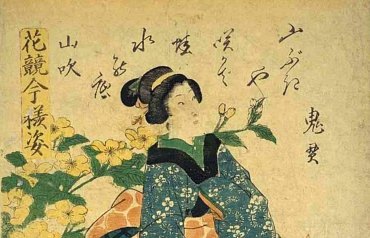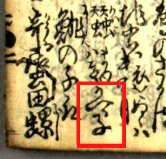Unpasteurized narcissism

Posting will be light this week.
I mentioned Shin-kokin-chō the other day. Scholars have, of course, discerned corresponding "tones" in the regular Kokinshū (Kokin-chō) and its predecessor the Manyōshū (Manyō-chō).
Kokin-chō is considered "feminine", and content-wise its main distinguishing feature is its heavy reliance on puns, metaphors, and the like. The general image of classical Japanese poetry as a delicate arrangement of allusions and innuendo is entirely due to the lasting influence of Kokin-chō. Manyō-chō, on the other hand, is "masculine": direct, vivid imagery; relative metric freedom; heavy use of "pillow words".
That's not to say that there are no metaphors or wordplay in the Manyōshū. There are plenty. They just aren't quite as subtle. For instance, consider this poem by Fufuki no Toji ("Lady Fufuki", 吹黄刀自), allegedly inspired by Emperor Tenmu's daughter Tōchi no Himemiko (十市皇女)'s visit to Ise shrine.
河の上のゆつ岩群に草むさず常にもがもな常処女にて
kawa no [u]e no/ yutsu iwamura ni/ kusa musazu/ tsune ni mo ga mo na/ toko-otome ni te
In the river/ the sacred clustered rocks/ do not sprout grass/ Would that [you] were ever thus--/ an eternal maiden
I'm sure it was all well and good back then, but for a modern reader, that poem starts to get creepy by about ku four.
A man walks into the public bath. He washes himself without incident, but as soon as he steps into the water he grimaces and says: "Ugh... I feel seasick."
"Seasick?!" says the man next to him. "This isn't the sea. We aren't even on a boat!"
"I know, but that bearded guy over there looks just like a sailor."
This late-autumn tanka was penned by by SONE no Yoshitada (曽根好忠) and can be found in the Shin Kokinshū:
人は来ず風に木の葉は散りはてて夜な夜な蟲の聲弱るなり
Hito wa kozu/ Kaze ni konoha wa/ chirihatete/ yonayona mushi no/ koe yowaru nari
People do not call/ The leaves have blown away in the wind/ And every night the cries of the insects seem weaker
This poem is an excellent example of Shin-kokin-chō (新古今調, "Shin Kokinshū tone") in many ways: its twilight-of-the-nobles feel, its phantasmagoric rather than direct emotional use of the natural world, even its 1-4 structure (breaks after the first five-syllable ku).
Mind you, Yoshitada wrote it more than a century before the SK editors were even born. He was ahead of his time. Pessimists often are.
Candidate Hoshino Aki at Néojaponisme.
Last week, Shōnen Magazine (2007/45) broke the news that bikini idol Hoshino Aki intended to run for election as a member of the Japan ☆ Idol Party (日本☆アイドル党公認)...
I hate it when lazy writers fall back on the cliche of likening anything Japanese and unusual to a video game or cartoon, but even I have to admit that Enoshima from above is a fusion of the organic and the artificial straight out of Akira.

Forested and craggy at one end, planed and augmented at the other, with secret escalators that go right through its rocky heart and emerge at its peak.
Which is my late-night way of leading up to Robert A. Juhl's The Goddess, the Dragon and the Island: A Study of the Enoshima Engi (History of Enoshima Temple): Part 1.
The core of this study is my translation of the first segment of the Enoshima Engi (江嶋縁起), the first in a western language. The Enoshima Engi is a history of the temples/shrines on Enoshima Island. [...] Written in Chinese by the learned Buddhist monk Kokei (皇慶) in 1047 AD, this segment of the Enoshima Engi relates an apparently fabulous story of a destructive five-headed dragon that lived in a large, swampy lake along the course of a local river in the period prior to the sixth century AD. The dragon plagued the inhabitants of the low coastal hills in the vicinity of Enoshima, causing floods and swallowing children.
[...] This study assembles evidence and/or documentation to support the view that [...] [the] dragon represented the violent local river and its four major tributaries as seen from the hills where the ancient inhabitants lived.
A great resource, and not at all stingy with the Chinese and Japanese sources.
WIFE: We are not naming our first child Gizaemon.
ME: All right, we can compromise. Sanshirō.
WIFE: You mean like the book?
ME: Right.
WIFE: No. But I'm not opposed to a name from Sōseki in principle.
ME: Let's see... the cat still hasn't got one...
WIFE: Sensei?
ME: Watashi?
WIFE: ... K?
ME: Sōseki might be a dead end.
To wrap up the week of frogs, here's a detail from a Yoshitora print featuring a haiku by Onitsura (if I am reading those kanji on the right correctly):

山ぶきや咲かで蛙ハ水の底
The kerria flowers not, and the frog is deep underwater
I suppose the idea is that the woman is so beautiful that natural phenomena pale in comparison? If you have a better interpretation, please help me out. (Also note that both "kerria" and "frog" are associated with spring.)
Responding to my Monday post about tadpoles and snails, Thomas asks: "So what's the difference between the two words for frog: kaeru and kawazu?" The common answer is that kawazu is the "old word" that got replaced by the "new word" kaeru, but this is a misconception. It's really just another case of semantic overlap combined with poetic versus everyday register.
It's true that there are no kaeru as such in the Manyōshū -- all the frogs that appear as frogs are kawazu (/kahadu/, at the time). But this is not because the word kaeru had yet to be invented. How do we know this? Because it appears inside other words -- specifically, kaerude (literally "frog hand"), which became the modern word kaerude, maple. Check out this poem by Lady TAMURA (田村大嬢) to her younger sister:
wa ga yado ni/ momitu kaherude/ miru goto ni/ imo wo kaketutu/ kohinu hi ha nasi
吾屋戸尓/ 黄變蝦手/ 毎見/ 妹乎懸管/ 不戀日者無
Every time I see the maple leaves turn in my garden, that day does not exist, O sister, which does not find me longing for your company
Some versions have momituru kahede or some minor variation, but the use of the kanji 蝦, which means "toad" or "big frog", to get the kae(ru) sound is constant. So, the word was there. Why didn't they use it?
One reason was that kaeru was a general word, while the original meaning of kawazu seems to have specifically been "kajika frog". The kajika frog is so called because it lives in rivers (ka(wa)) and has a haunting call like a deer (shika), making it ideal for use in poetry. Virtually all of the Manyōshū poems that include a kawazu specifically refer to its call.
Maybe for this reason, kawazu also seems to have been the preferred word in poetry for frogs in general. There is a word for this in Japanese aesthetics: kago (歌語, "poetry word"). Another good example is references to cranes: the word tsuru is plenty old (some say it came over direct from the continent), but most early poems used the word tazu (たづ) instead. That was the kago.
So maybe kawazu originally meant "kajika frog" in particular, but it didn't take long before it just meant "frog [+poetic]" in general. Meanwhile, kaeru was a perfectly healthy synonym meaning "frog [-poetic]".
Eventually, poetry would be modernized in such a way that people felt quite comfortable using the word kaeru, which left kawazu stranded, gradually shifting towards meaning simply "frog [+archaic]". Kaeru, on the other hand, became simply "frog" (unmarked).
Kawazu would probably have been forgotten by all but the specialists by now (much like tazu) if it weren't for one thing: the Dark Side of the Moon of traditional Japanese poetry, that one haikai by Bashō that everyone knows...
古池や かはづ飛び込む 水の音
Furuike ya/ Kawazu tobikomu/ mizu no oto
Old pond/ Frog jumps in/ Sound of water
Bonus fact: Bashō was actually consciously playing with the kawazu tradition here by attributing the sound to the water rather than the frog. The frog's implied silence, after centuries of naku kawazu, is a crucial part of the stillness that allows the sound of water to make its impact.
Joel talks snails and tadpoles before invoking the me-signal. It's on!
One reason that it's hard to find haiku about otamajakushi (tadpoles) is because otamajakushi is a relatively new word -- like Joel says, it was originally used to refer to a ladle with a big round scoop (hence tama, "ball"). A regular shakushi has a shallower scoop, almost like a spatula, but that word isn't used much any more: like many kitchen-related items, it went through the nyobokotoba ("women's language") machine and came out shamoji ("Sha-word").
And in fact, the o- at the start of otamajakushi reveals that it, too, was forged in the fires of medieval Japanese women's language. What's more, it has been shortened in the centuries since to otama, and otamajakushi pretty much always means "tadpole". But there was a long period in between, I imagine, where there was some severe overlap, and calling tadpoles otamajakushi struck folks as far too cutesy for use in serious poetry.
So what were they called before the invention of the ladle? Kaeru no ko or kaerugo (frog children), or the Chinese word for tadpole kato (蝌蚪). This site has more information, and even a modern haiku that does use the word otamajakushi, by MASAOKA Shiki (natch):
裏溝やお玉杓子の水ぬるむ
"The ditch out back: tadpole water warming up." (Mizu nurumu is a standard haiku "season phrase" for spring.)

As for katatsumuri and dendenmushi for "snail", YANAGITA Kunio (柳田國男) ground the subject to a fine paste in Kagyū kō (蝸牛考, "On snails") and I recommend it to anyone interested in Japanese regional variation in non-aquatic mollusc-related terminology. (Yes, both of you.)
I understand that Yanagita himself had grave doubts about the broader ideas he expressed in the book -- the "center versus periphery" part about culture radiating outwards in concentric circles from Kyoto to the edges of the Japanese archipelago, I guess? -- but the hundreds of different words for "snail" he collected are still impressive. To summarize his interpretation:
Three other great words for "snail" to close: hebitama (snake-ball), iekatsugi (house-shoulderer), and gamahime (toad/pot princess? some variant of maimai?).
Two foot-tappin' numbers from Minna no Uta ("Songs for everybody"), a venerable NHK feature vaguely resembling the less explicitly alphanumerical songs from early Sesame Street.
Item: "Ninja wa doko ja" ("Where's the ninja?"). It is illegal in Japan to mention a ninja in a poem or song without associated wordplay involving the archaic/regional variant copula ja; these lyrics are an excellent example of how it should be done.
On the surface, "Ninja" is a tragic tale narrated by a small boy who finds himself the victim of an ongoing campaign of harassment carried out by a single ninja whose employers remain unseen. The associated animation, however, problematizes the narrator's claims, not so much by accusing him of dishonesty as by calling into question the significance of any distinction between the boy and his adversary.
Ultimately, the visuals argue, the "ninja" is simply an Other invoked by the boy to explain -- or, rather, not explain -- events that are repellent to his Self. It follows that those around him reject these claims, since to them the boy and the "ninja" are merely hypothetical subdivisions within a single opaque Other.
I also really like his mother's outfit in the classroom scene.
Item: "Aka-oni to Ao-oni no tango" ("Red oni/blue oni tango"). A red devil and a blue devil find happiness with each other in the dead of night; an eerie down of identical rabbits look on, withholding explicit judgement but supplying the necessary rhythm with hushed cries and stabbing violins.
And is the nod to De sterrennacht only my imagination?
Lovely example of the multi-level lexicon in action:
| 加齢からくる肌トラブルをなかったように | 若さからくる肌トラブルをなかったように |
| Karei kara kuru hada toraburu o nakatta yō ni | Wakasa kara kuru hada toraburu o nakatta yō ni |
| Make skin trouble caused by maturity disappear | Make skin trouble caused by youth disappear |
I've tried to reflect the key difference in my translation: the word corresponding to "youth" is wakasa, as native as a Japanese word can get -- but the word corresponding to "maturity" is karei (加齢, "increased years"), a Chinese-character compound imported from the mainland or designed to sound as if it were.
It's not that there aren't any Japanese words that you could use there. The obvious choice is toshi, meaning "year[s]" or "age" (with the implication "advancing" in cases such as this). But this would be... indelicate. Sino-Japanese words are the vaseline on the lens that lets everyone pretend they can stay young forever -- just like Latinate words are in English.
(Speaking of which, yeah, English "trouble" is in there too. I'll leave that as an exercise for the reader.)
Incidentally, these characters are supposed to be mother and daughter. The mother's backstory is that she considers her daughter both a comrade and a rival ("良き仲間でもある") when it comes to beauty. The daughter's bio does not mention her mother at all. That's brutal, Cezanne. Brutal but hilarious.
KYAN Chiaki's surname looked made-up to me the first time I saw it. It's spelled 喜屋武, "ki-ya-mu", which sound change would indeed eventually grind down to "kyan" or even theoretically "kyō"... but come on. Kyan?
Turns out I was as wrong. Ethnocentrically wrong. I don't know if it's her real surname, but it's definitely a real surname -- from Okinawa. Word on the street is that it's the 45th most common surname there, and the 2820th nationwide (88% of 喜屋武s live in Okinawa). Karate master KYAN Chōtoku was another famous 喜屋武.
He was also alive long enough ago to have fallen victim to Chan/Kyan confusion. Y'see, the sound in Okinawan that corresponds to Japanese /ky/ is /ty/ (e.g. kyaku ⇔ chaku), and sure enough this name used to be pronounced "Chan" too. Implementing a nationwide standard Japanese was a major goal of the Meiji government, and that included the "normalization" of Okinawan place names. And so, by 1903, the official pronunciation of the village 喜屋武 had already been changed from "Chan" to "Kyan". Later, in 1937, a law was passed making mainland pronunciations for Okinawan surnames compulsory, and 喜屋武 was apparently changed all the way to "Kiyatake" in some cases. (/take/ is another standard SJ pronunciation of the final kanji, 武).
And there are the usual slight variants: Google confirms Kyatake, Kiyan, and Kiyabu, to list just three.
Summary: Chiaki's surname is real, and it's spectacular.